Motorola One Zoom review

Versatile camera setup
Just like the name suggests, the Moto One Zoom banks hard on its camera setup. And indeed, you do get a pretty versatile setup, especially for a mid-ranger. The main sensor is the popular 48MP supporting pixel-binning technology, and it's paired with a bright f/1.7 aperture and OIS for less shaky images. There's also a 16MP sensor coupled with an ultra-wide lens with f/2.2 aperture and 117-degree field of view.

The third camera on the list is the 8MP telephoto unit capable of 3x zoom, has OIS, and features f/2.4 opening. It's nice to have a 3x lossless zoom at this price. Even some flagships are stopping at 2x, so kudos to Motorola.
And lastly, the fourth camera is a 5MP depth sensor, mainly used for the bokeh-like effects when shooting portraits. On the front - a 25MP, f/2.0 snapper using Quad Pixel technology to output 6.25MP stills.
But before we discuss camera quality, we need to talk about the Camera app itself since Motorola has put a lot of effort into it. It is quite feature-rich, even if a bit chaotic at times. All the various prompts and labels that pop up once a particular bit of the AI and scene recognition gets triggered are particularly annoying. Especially when they get stacked together at the same time.
Most of the options on the left-hand side of the UI are pretty self-explanatory, perhaps with the exception of the crossed-out shutter button. That controls Active Photos, which is Motorola's take on Live photos. In other words, setting this to on makes the phone record short clips when you press the shutter for a still. That way, you get both and more of that particular moment in memory. You can have the feature on, off, or set it to Auto and led the One Zoom to decide if enough is going on to record video. Using Active Photos, however, means you can't have a flash or HDR on.
On the right-hand side, you get some nifty live color filters and access to the rest of the One Zoom's photo and video modes. Once you start using these, the main UI starts swapping in a quick icon for your most commonly used special mode right next to the modes button itself. Very convenient.
The settings menu is also quite feature-packed, but also rather confusing. What we mean in particular is the way video resolution controls work. On the one hand, Motorola went the extra mile and made separate menu entries for the front and rear cameras. However, the actual resolution options do change depending on the camera you are using. That is, only the main camera can go up to 4K. Once you switch over to either the zoom or the ultrawide, you only get 1080p, and there is no real way of knowing it unless you check back into the settings menu.
Photo quality
As is common for the current wave of Quad Bayer snappers, the 48MP unit in the Motorola One Zoom captures 12MP stills by default. These come out with plenty of detail and nice colors. However, there are plenty of issues with the photos, as well. Primarily the general softness throughout the frame. It gets so bad at times that we almost thought the lens was smudged, or the focus was malfunctioning. That wasn't the case, though.






Motorola One Zoom regular camera samples
Turning HDR mode on does seem to help with these issues a bit, as in we do get generally sharper photos. However, pixel-peeping at the pictures we can see that any place in the frame the HDR algorithm ignored, for some reason, still looks just as blurry as without HDR. So, what we are looking at here is artificial sharpening and even over-sharpening in certain spots resulting in a somewhat inconsistent look.






HDR: Off • On • Auto • Off • On • Auto






HDR: Off • On • Auto • Off • On • Auto
This over-sharpening issue is particularly noticeable with low-light shots taken in Night mode as well. But more on that in a bit.
First, however, we have to look at some of the other cameras and modes. While most Quad Bayer shooters allow the user to capture a full-resolution still, the Motorola One Zero offers another, slightly different Bayer mode - 8MP.
For whatever reason, photos taken in this mode appear noticeably sharper than regular 12MP ones. The general softness is almost entirely gone. Granted, some of that could be due to the lower output resolution. However, even when pixel-peeping, results do look better. If you don't mind the lower resolution, this mode might be a better bet.
Moving on to the 8MP, f/2.4 telephoto, we found fewer issues and plenty to like. The optical image stabilization works particularly well and makes for a really "floaty" viewfinder. Not great if you are after precise framing, but pretty essential for using the 3x telephoto handheld.






Motorola One Zoom 3x camera samples
Detail is plenty. Edge to edge sharpness is also great. No blurriness like on the main camera. Noise is kept well at bay. The colors are nice and natural. Overall, using the zoom camera offers an excellent telephoto experience.
Of course, you can also use HDR for the telephoto, but the effect with the zoom camera is a lot less pronounced - ou could call it subdued and even mature in terms of processing.






Motorola One Zoom 3x camera HDR: Off • On • Auto • Off • On • Auto
There is one bug worth noting here with HDR and the Auto setting in the telephoto mode in particular. On occasion, it tends to go out of whack and cartoonishly over-sharpen everything. It rarely does it twice in a row, so it's not a deal-breaker. Hopefully, Motorola addresses that, though.






Motorola One Zoom 3x camera HDR bugs
The 16 MP, f/2.2, 13mm ultrawide snapper on the Motorola One Zoom is about on par with what you can commonly find on a mid-ranger these days. That is to say, it yields perfectly usable results, especially for casual, social network purposes. However, like most ultra-wide cameras on smartphones these days, quality is not spectacular though we've certainly seen worse than that.






Motorola One Zoom ultrawide samples






Motorola One Zoom ultrawide camera HDR: Off • On • Auto • Off • On • Auto






Motorola One Zoom ultrawide camera HDR: Off • On • Auto • Off • On • Auto
HDR genuinely helps these shots pretty much all around. Colors seem to get the most benefit out of the HDR treatment.
Before we wrap-up the general still photo camera quality, here are a few other random photos.






Motorola One Zoom camera samples
And for your pixel-peeping pleasure, here is the Motorola One Zoom in our pic compare database.



12MP: Motorola One Zoom against the Xiaomi Mi 9T and the Relame 5 Pro in our Photo compare tool
A few words about low-light performance are definitely in order as well. Especially since the Motorola One Zoom has a dedicated Night mode. Generally speaking, in regular 12MP mode, the photos suffer from the same issues as during the day. The worst of which has to be the excessive softness.
Night mode works as intended in brightening up the entire frame. We would even go as far as to call it impressive in this regard. However, since it is using some of the aggressive algorithms from general HDR, things tend to look comically over-sharpened. And again, the effect is not necessarily uniform.



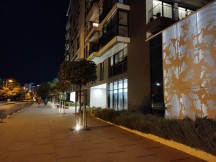
Motorola One Zoom 12MP low-light samples
So what you end up with is a photo in which most things like leaves and relatively smooth surfaces appear very soft while certain sports containing patterns that the algorithm did manage to recognize, like tiles, appear almost entirely artificially painted on. Not a great result.
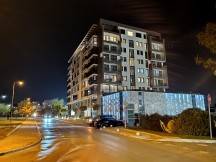



Motorola One Zoom 12MP Night mode samples
Unlike many other phones that instantly switch over to a crop of the brighter main camera when the lighting gets too low, the Motorola One Zoom continues to use its f/2.2 telephoto lens regardless. A pretty bold choice. Perhaps a bit too bold.






Motorola One Zoom 3x low-light samples
To be fair, the One Zoom did snap and crop a zoom out of the main camera on occasion, but that rarely happened. Also, we had no luck deliberately triggering said behaviour. Light does not seem to be the deciding factor. Perhaps there is some camera software issue at play here.

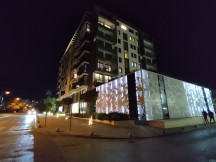


Motorola One Zoom ultrawide low-light samples
Night mode is only limited to the main camera, so you can't trigger it in either zoom or ultrawide mode. A shame, really, since both other snapper could definitely benefit from some well-executed HDR.




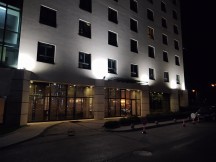
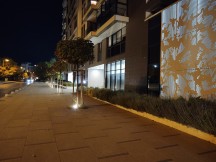
Motorola One Zoom 8MP low-light samples
Last, but not least, the odd 8MP mode on the main snapper remains an option when the light get low. It does appear to provide a slight advantage in overall quality under these conditions as well. You can also have Night Mode in this resolution setting.






Motorola One Zoom 8MP Night mode samples
We did notice a rather odd behaviour with 8MP and Night mode, though. There seems to be a consistent and rather unexplainable crop applied to these photos. In contrast, there is no such issue when shooting 12MP Night mode stills. More software weirdness.
Before we move on to video selfies, all of Motorola's additional options and special camera modes do deserve at least some recognition. Most of these, like Spot Color and Cutout, aren't exactly new. Even so, the depth of some things, like the selection of live filters, as well as the success with which the effects work is rather impressive.
Selfie quality
There is a 25 MP, f/2.0, 0.9µm snapper on the front of the Moto One Zoom. It is nothing too fancy, just a fixed-focus unit. Just like the primary camera on the back of the phone, the selfie gets binned down to a 6MP output image.






Motorola One Zoom selfie samples
Selfie quality is quite impressive. Aside from the occasional blurry spot in the background, shots look nearly perfect. Plenty of detail and mature color science. It is worth noting that there is some amount of "beautification" on by default.
Speaking of Beauty mode, it is just the tip of the iceberg of options for the selfie camera. You get both an auto setting and an intensity slider for Beauty mode. Beyond it, there are also an impressive selection of color filters as well as a versatile portrait mode. The latter includes a few artificial lighting options, including a studio mode, not unlike what Apple is doing. And there are also settings for the background blur intensity.
Considering the lack of any dedicated depth capture hardware on the front of the Motorola One Zoom, most of these effects work impressively well. You can also mix and match most things for a unique look.
Video quality
The Motorola One Zoom can capture video with all three of its cameras. However, you can only do 4K 30fps on the main camera. The ultrawide and the telephoto only go up to 1080p. Format-wise, you get a pretty standard setup - AVC + a stereo AAC stream, inside an MP4 container. FPS is pretty much rock steady, and you get about 51 Mb/s in 4K and 21 Mb/s in FullHD as the video bitrate.
Quality-wise, 4K is decent, but not spectacular or flagship-grade. Colors are a bit oversaturated, and the dynamic range is a bit lower than we would have liked. The main issue, though, is over-sharpening. It is very aggressive and results in quite a bit of motion jitter in high-frequency detail like leaves. It's a very aggressive look, overall.
FullHD on the main camera looks even more aggressively over-processed since there is a surprising downgrade in resolved detail. All the other issues 4K has are still present as well.
Interestingly enough, just like with still, the 3x telephoto seems to fair a lot well in video capture as well. Colors look better, the picture is not nearly as overprocessed, and even the detail is better. Of course, considering the 1080p resolution. Thanks to the excellent OIS stabilization, you can take some usable long-range video clips with the Motorola One Zoom.
Ultra-wide videos, unfortunately, look more similar to the regular clips than the telephoto ones. That is to say, plenty of over-sharpening and a quite aggressive look. Corner softness seems to be a problem area as well.
Aside from OIS, the primary camera does also offer additional EIS for up to 4K video capture. However, in its current state, it seemed to do more harm to the stability of the video than anything else, so we would probably skip it. OIS works perfectly fine on its own.
Last, but not least, we also took some clips of our standard set of posters and picked out the best frames we could for your pixel-peeping needs.



Motorola One Zoom against the Xiaomi Mi 9T and the Relame 5 Pro in our Video compare tool
Reader comments
- Hus
- 14 Aug 2024
- srr
I'm still using it 8hrs a day in 2024. Best sound ever heard for music. Richest tones, like in Dolby digital. It keeps me 10-11 hrs on browsing. Only disadvantage is the sound volume on recording video, which is lower than others. Great ph...
- Fa14bi
- 08 Nov 2022
- skG
2 Years later and the 2018 chipset 675 does still beat the 695 since it can do 4K at 200 bit rate, meaning the phone can burst out Full sized 8MP pictures 30Times a secound. (Samsung 8K doesn't even reach a 200 bit rate, so the details on this ...
- Gdub
- 28 Oct 2020
- kXA
Are you kidding? Stock Android is the best. This phone isn't lagged down by an annoying skin like samsung s series. It also already has the newest version of Android thanks largely to the limited altered UI. It makes it nearly as quick as a fla...



































